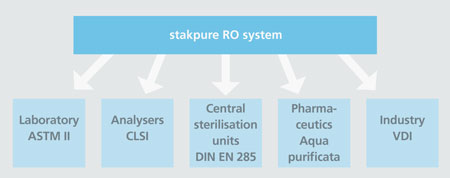Stakpure technológiai háttér
A fordított ozmózis (RO), valamint a fordított ozmózis elektro-deionizációval kombinálva (RO ED) a sómentes tiszta víz előállításának hatékony módjai központosított tisztított víz-ellátás során
Fordított ozmózis (RO) és elektro-deionizáció (ED)
A fordított ozmózis a természetes ozmózis folyamat megfordítása nyomás hatására: túlnyomást alkalmazva a töményebb oldat oldalára a természetes ozmózis áramlás iránya megfordul, és a sómentes víz a töményebb oldat felől a hígabb oldat irányába áramlik.
A fordított ozmózis során használt membrán vízáteresztő képessége folytán kiszűri a tisztításra szánt vízben lévő szinte összes fizikai és kémiai szennyezőanyagot, valamint a biológiailag aktív alkotókat is.
A módszer egyre elterjedtebb a különböző ipari folyamatokban, laboratóriumi felhasználásban és olyan más helyeken, ahol nagy tisztaságú víz biztosítása szükséges.
A Stakpure fordított ozmózis (RO) készülékei hatékony és költségkímélő megoldást nyújtanak a központosított tisztított víz-ellátásra a laboratóriumok, az egészségügy, a gyógyszergyárak, valamint ipari létesítmények számára.
Tipikus visszatartási tényező – Stakpure fordított ozmózis (RO) készülékek:
• ásványi anyagok: 99%
• baktériumok: 99%
• részecskék: 99%
• pirogének: 99%
A víz tisztítására vonatkozó követelmények maximális teljesítése érdekében elektro-deionizációs (ED) eszköz alkalmazható a fordított ozmózis készülék után a visszamaradt árványi anyagok eltávolítására, mely két folyamatot kombinál: elektrodialízis és ioncsere.
Ily módon 0.067…1 μS/cm minőségű tisztított vizet nyerhetünk.
Az elektro-deionizációs eszközben lévő kevertágyas gyanták elektromos áram segítségével történő folyamatos regenerálása hozzájárul a nagy tisztaságú víz előállításához vegyszerek hozzáadása nélkül.
Előnyei:
• egy központi készülék – helytakarékos megoldás
• nincs regenerációs költség
• nincs vegyszerfelhasználás
• részecske- és baktérium mentesség
• nagy tisztított víz hozam
• moduláris kapacitásnövelés lehetősége
A fordított ozmózis (RO), valamint a fordított ozmózis elektro-deionizációval kombinálva (RO ED) a sómentes tiszta víz előállításának hatékony módjai központosított tisztított víz-ellátás során
Fordított ozmózis (RO) és elektro-deionizáció (ED)
A fordított ozmózis a természetes ozmózis folyamat megfordítása nyomás hatására: túlnyomást alkalmazva a töményebb oldat oldalára a természetes ozmózis áramlás iránya megfordul, és a sómentes víz a töményebb oldat felől a hígabb oldat irányába áramlik.
A fordított ozmózis során használt membrán vízáteresztő képessége folytán kiszűri a tisztításra szánt vízben lévő szinte összes fizikai és kémiai szennyezőanyagot, valamint a biológiailag aktív alkotókat is.
A módszer egyre elterjedtebb a különböző ipari folyamatokban, laboratóriumi felhasználásban és olyan más helyeken, ahol nagy tisztaságú víz biztosítása szükséges.
A Stakpure fordított ozmózis (RO) készülékei hatékony és költségkímélő megoldást nyújtanak a központosított tisztított víz-ellátásra a laboratóriumok, az egészségügy, a gyógyszergyárak, valamint ipari létesítmények számára.
Tipikus visszatartási tényező – Stakpure fordított ozmózis (RO) készülékek:
• ásványi anyagok: 99%
• baktériumok: 99%
• részecskék: 99%
• pirogének: 99%
A víz tisztítására vonatkozó követelmények maximális teljesítése érdekében elektro-deionizációs (ED) eszköz alkalmazható a fordított ozmózis készülék után a visszamaradt árványi anyagok eltávolítására, mely két folyamatot kombinál: elektrodialízis és ioncsere.
Ily módon 0.067…1 μS/cm minőségű tisztított vizet nyerhetünk.
Az elektro-deionizációs eszközben lévő kevertágyas gyanták elektromos áram segítségével történő folyamatos regenerálása hozzájárul a nagy tisztaságú víz előállításához vegyszerek hozzáadása nélkül.
Előnyei:
• egy központi készülék – helytakarékos megoldás
• nincs regenerációs költség
• nincs vegyszerfelhasználás
• részecske- és baktérium mentesség
• nagy tisztított víz hozam
• moduláris kapacitásnövelés lehetősége
